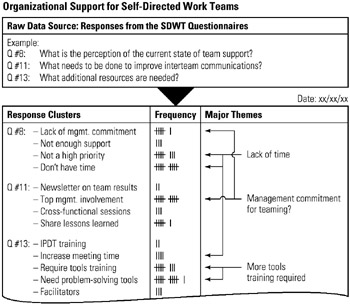Tool 200: Thematic Content Analysis
| AKA | N/A |
| Classification | Analyzing/Trending (AT) |
Tool description
A thematic content analysis is used to surface clusters or patterns of related data among raw data collected from survey respondents. The purpose for this analysis is to identify major recurring themes that reflect respondents' concerns or perceived problems.
Typical application
-
To uncover concerns, issues, or potential problems in an organizational survey results analysis.
-
To count and allocate similar responses into category or major themes.
-
To identify related data clusters or patterns among respondents' data.
Problem-solving phase
| Select and define problem or opportunity | |
| → | Identify and analyze causes or potential change |
| → | Develop and plan possible solutions or change |
| Implement and evaluate solution or change | |
| → | Measure and report solution or change results |
| Recognize and reward team efforts |
Typically used by
| 1 | Research/statistics |
| Creativity/innovation | |
| Engineering | |
| Project management | |
| Manufacturing | |
| 2 | Marketing/sales |
| Administration/documentation | |
| Servicing/support | |
| 3 | Customer/quality metrics |
| Change management |
Notes and key points
-
Typical raw data collection methods are mailed questionnaires, various types of surveys, focus groups, and interviews.
before
-
Data Collection Strategy
-
Focus Group
-
Surveying
-
Interview Technique
-
Questionnaires
after
-
Cluster Analysis
-
Customer Satisfaction Analysis (CSA)
-
Consensus Decision Making
-
Different Point of View
-
Response Data Encoding Form
Step-by-step procedure
-
STEP 1 Upon the completion of an organizational survey, employee opinion survey, or other data collection effort, the response data is sorted and identified for a thematic content analysis. See example Organizational Support for Self-Directed Work Teams.
-
STEP 2 A thematic content analysis form is prepared by the data analyst. This form is used to record the responses of interest.
-
STEP 3 All data are examined and similar responses are combined for each question of interest. Frequency data of how often this response was given is also recorded as shown in the example.
-
STEP 4 Finally, when all meaningful response data have been recorded and summarized, major themes are identified using linkages, as shown in the example.
-
STEP 5 The completed document is dated and presented to the quality department's management for further action.
Example of tool application

EAN: 2147483647
Pages: 326